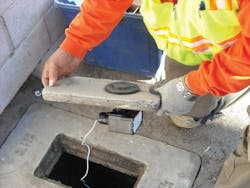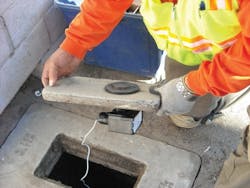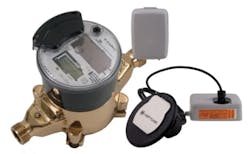Innovative Technologies Improve SSES Processes From Field Inspection to Rehabilitation
By Eric MacDonald
In recent years, GPS technology has become more commonplace in our everyday lives. Private companies and public utilities alike have integrated GPS with GIS technology into mapping, surveying and construction efforts to improve project quality and streamline ongoing project management. An example is the highly successful employment of these tools by many public utilities performing sewer system evaluation surveys (SSES) to locate and document infiltration and inflow defects.
Regular sewer system evaluation surveys are vital to ensure proper operation and maintenance of the nation’s sewer systems. Municipalities are encouraged to establish a proactive approach for managing wastewater collection and treatment facilities by adhering to the Federal Government’s Capacity, Management, Operations and Maintenance (CMOM) guidelines.
Historically, data gathered from sewer condition assessments resulted in cumbersome, incomplete reports generated through largely manual data collection processes. Fortunately, the methods used to perform sanitary sewer system assessments have improved dramatically in recent years. For those utility investigators who are tasked with providing condition assessments, new tools and technologies are available that not only help institute a proactive CMOM approach but also promise dramatic improvements in quality, accuracy, data storage, reporting and process efficiencies.
Important Considerations
While the advantages are numerous, there are several factors to consider before jumping in feet first with the implementation of these new methods of performing sanitary sewer conditions assessments. First, public utility managers must have a clear idea who will be responsible for collecting data and if training is required for its personnel. Second, a methodology that defines the purpose, scope, frequency of data collection, and location where data ultimately will be stored must be defined. Naming conventions of manhole and pipe attributes must be defined and agreed upon in advance.
Managers must ensure that the new tools and equipment are compatible with GIS and computerized maintenance management system (CMMS) software. They also must consider:
• Will the data collection process adhere to pipeline and manhole assessment certification programs (PACP and MACP)?
• Will defects be tracked through a work order system connecting to a CMMS to facilitate future management of issues?
• Is the intention of the data collection to be a continual record of sewer conditions that could potentially track and show the degradation that has occurred over time?
GIS/GPS Survey Tools
Utility crews must have a suite of tools at their disposal to successfully capture GIS/GPS-based data in a variety of field applications. A ruggedized field computer (sometimes referred to as a “pentop”) is the brain of this toolset. Pentops will need to have built-in GPS capability and have installed digital mapping software that allows field workers to appear live on the active layer of the GIS map.
Digital video and digital photography cameras are essential to documenting the type, severity and magnitude of defects and must have the capability to feed live video and photos to the GIS application. Pipe-mounted digital cameras (PipeCams) with built-in lighting are mounted at the end of long poles and grant field crews live, remote access to sewer pipes that would have previously required physical entrance to obtain.
Finally, a variety of GPS receivers are available to provide active locating at varying degrees of accuracy. Field workers can mount the GPS antennas on their person or place the antenna in a location of interest in a particular investigation (manhole, pipeline, etc.).
Data Collection, Reporting
Once the GIS-based data collection system is in place, field crews now have a live presence on the GIS map. What this means is that the surveyor in the field shows up on the map in his live location, and he can use the map to help navigate to obstructed manholes (hidden by sand, gravel, debris, etc.). Using the pentop to view the live GIS map, a surveyor can physically locate a manhole and then update and “snap in” the actual location that updates instantly on the live GIS map. In addition, while the surveyor snaps in new features on the map (e.g., pipes and manholes), he can also delete old manholes and other attributes that are no longer accurate. By doing so, the surveyor is creating a real-time view of the sewer system so that the next time a surveyor comes to that location, the map is already updated and accurate.
Of course, while the defect is documented more accurately using a GIS basemap, the basemap also obsoletes the cumbersome task of manually drawing the map of the region surrounding the defect itself. Traditionally, surveyors had to put a large amount of time and effort into creating this context, and now this is handled wholly, and incidentally, by the GIS basemap. Since the basemap already has the surrounding region constructed, the surveyor can focus on the defect and capture the descriptive details needed for evaluation.
Nothing aids documentation and reporting more than visual references. Using the new GIS data collection, all digital photography or digital video that is captured during inspection of a structural defect is directly linked to the defect on the GIS basemap. This allows the surveyor to add as much visual documentation to the project as he sees fit.
GIS technology enables surveyors to compile a spatial database and corresponding graphical data view that displays defects and attributes in the database as points on the map. The severity of the defects can be depicted graphically with a color scheme that provides a visual representation of a region’s sewer system defects. Points can easily be plotted between spreadsheet and map to allow for simple, ongoing updates to reporting data.
The GIS allows for graphical data views to be created for all types of sewer system evaluations, from manhole inspections to smoke tests and dye floods. For each type of test, sewer system attributes defined in the database enable the field surveyor to provide consistent and thorough reporting of conditions in the field. Surveyors can include MACP and PACP standards in their database of condition attributes to ensure capturing the data necessary for adherence to these certifications.
Leveraging SSES
SSES is an effective method to determine where infiltration and inflow (I/I) exists in a system. Using the innovative methods described above enables SSES data to be collected in a GIS format without cumbersome post-processing. This is beneficial as most asset management systems today use GIS data as the medium to schedule maintenance for their assets.
Going beyond scheduling maintenance, Woolpert has created a software program called Infrastructure Optimization (IO) that extends the functionality of an asset management system. IO brings all asset data (including SSES data) into a single view, and helps users calculate a Business Risk Exposure (BRE) score for all assets. BRE is a function of multiplying the probability of failure by the consequence of failure. This enables the creation of a prioritized list of planned maintenance based on risk. IO also allows users to test different repair and replacement maintenance strategies (and associated costs) so they can optimize and balance operating and capital improvement plan (CIP) budgets.
Reducing I/I – A Watershed Approach
Reducing I/I in a sewer system requires a thorough understanding of the watershed hydrology. It is not always possible to remove I/I sources without providing improvements to the local drainage systems. Through the use of hydrological models, utilities can determine where the use of stormwater best management practices (BMPs) can help reduce the surface water problems caused by sewer rehabilitation. By using green infrastructure improvements, such as bio-swales, utilities can improve the overall water quality of the watershed.
Summary
Whether it is streamlining GIS processes with the latest GPS technologies, gaining access to advanced graphical reporting, prioritizing the repair of I/I, or looking at reducing I/I from a watershed approach, there is a new, proven and more comprehensive way to conduct SSES. This new method helps meet regulatory compliance, prioritizes where I/I should be fixed, and optimizes already strained budgets.
WW
About the Author: Eric MacDonald is Project Director, Infrastructure Management, for Woolpert Inc. He may be contacted at [email protected].
Circle No. 261 on Reader Service Card
More WaterWorld Current Issue Articles
More WaterWorld Archives Issue Articles


